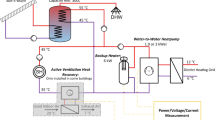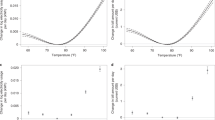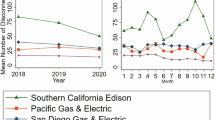Abstract
The timing of electricity consumption is increasingly important for grid operations. In response, households are being encouraged to alter their daily usage patterns through demand response and time-varying pricing, although it is unknown if they are aware of these patterns. Here we introduce an energy literacy concept, 'load shape awareness', and apply it to a sample of California residents (n = 186) who provided their household’s hourly electricity data and completed an energy use questionnaire. Choosing from four prominent load shape designations, half of respondents (51%) correctly identified their dominant load shape before COVID-19 shelter-in-place (SIP) orders while only one-third (31%) did so during SIP orders. Those aware of their load shape were more likely to have chosen evening peak, the most frequent dominant shape in the electricity data. Our work provides proof of principle for the load shape awareness concept, which could prove useful in designing energy conservation interventions and helping consumers adapt to an evolving energy system.
This is a preview of subscription content, access via your institution
Access options
Access Nature and 54 other Nature Portfolio journals
Get Nature+, our best-value online-access subscription
$32.99 / 30 days
cancel any time
Subscribe to this journal
Receive 12 digital issues and online access to articles
$119.00 per year
only $9.92 per issue
Buy this article
- Purchase on SpringerLink
- Instant access to full article PDF
Prices may be subject to local taxes which are calculated during checkout






Similar content being viewed by others
Data availability
The complete data analysed in the current study are not publicly available due to ethical restrictions and privacy of participant information. However, de-identified versions of the data are made available through the Open Science Framework at https://osf.io/4jxcm/ and https://doi.org/10.17605/OSF.IO/4JXCM.
Code availability
The code that supports analysis using de-identified versions of the data are made available through the Open Science Framework at https://osf.io/4jxcm/ and https://doi.org/10.17605/OSF.IO/4JXCM.
References
Armstrong, R. C. et al. The frontiers of energy. Nat. Energy 1, 15020 (2016).
Heptonstall, P. J. & Gross, R. J. K. A systematic review of the costs and impacts of integrating variable renewables into power grids. Nat. Energy 6, 72–83 (2021).
Jacobson, M. Z., Delucchi, M. A., Cameron, M. A. & Mathiesen, B. V. Matching demand with supply at low cost in 139 countries among 20 world regions with 100% intermittent wind, water, and sunlight (WWS) for all purposes. Renew. Energy 123, 236–248 (2018).
Sinsel, S. R., Riemke, R. L. & Hoffmann, V. H. Challenges and solution technologies for the integration of variable renewable energy sources—a review. Renew. Energy 145, 2271–2285 (2020).
Sovacool, B. K. The intermittency of wind, solar, and renewable electricity generators: technical barrier or rhetorical excuse? Utilities Policy 17, 288–296 (2009).
Eising, J. W., van Onna, T. & Alkemade, F. Towards smart grids: identifying the risks that arise from the integration of energy and transport supply chains. Appl. Energy 123, 448–455 (2014).
Jain, R. K., Qin, J. & Rajagopal, R. Data-driven planning of distributed energy resources amidst socio-technical complexities. Nat. Energy 2, 17112 (2017).
Jasiūnas, J., Lund, P. D. & Mikkola, J. Energy system resilience—a review. Renew. Sustain. Energy Rev. 150, 111476 (2021).
McPherson, M. & Stoll, B. Demand response for variable renewable energy integration: a proposed approach and its impacts. Energy 197, 117205 (2020).
White, L. V. & Sintov, N. D. Health and financial impacts of demand-side response measures differ across sociodemographic groups. Nat. Energy 5, 50–60 (2020).
PG&E’s Time-of-Use Rate Plans: Transition to Time-of-Use (PG&E, 2022); https://www.pge.com/en_US/residential/rate-plans/rate-plan-options/time-of-use-base-plan/time-of-use-plan/time-of-use-transition.page?
Attari, S. Z., DeKay, M. L., Davidson, C. I. & Bruine de Bruin, W. Public perceptions of energy consumption and savings. Proc. Natl Acad. Sci. USA 107, 16054 (2010).
Herrmann, M. R., Brumby, D. P. & Oreszczyn, T. Watts your usage? A field study of householders’ literacy for residential electricity data. Energy Effic. 11, 1703–1719 (2018).
Martins, A., Madaleno, M. & Dias, M. F. Energy literacy: what is out there to know? Energy Rep. 6, 454–459 (2020).
van den Broek, K. L. Household energy literacy: a critical review and a conceptual typology. Energy Res. Soc. Sci. 57, 101256 (2019).
Brewer, R. S. et al. Challenge: getting residential users to shift their electricity usage patterns. In Proc. 2015 ACM 6th International Conference on Future Energy Systems 83–88 (Association for Computing Machinery, 2015).
DeWaters, J. E. & Powers, S. E. Energy literacy of secondary students in New York state (USA): a measure of knowledge, affect, and behavior. Energy Policy 39, 1699–1710 (2011).
Hofman, H. Energy crisis—schools to the rescue again. Sch. Sci. Math. 80, 467–478 (1980).
Southwell, B., Murphy, J., DeWaters, J. E. & LeBaron, P. Americans’ Perceived and Actual Understanding of Energy (RTI Press, 2012).
Borgeson, S., Flora, J. A., Kwac, J., Tan, C.-W. & Rajagopal, R. in Design, User Experience, and Usability: Interactive Experience Design (ed. Marcus, A.) 337–345 (Springer International Publishing, 2015).
Kwac, J., Flora, J. & Rajagopal, R. Household energy consumption segmentation using hourly data. IEEE Trans. Smart Grid 5, 420–430 (2014).
Kwac, J., Flora, J. & Rajagopal, R. Lifestyle segmentation based on energy consumption data. IEEE Trans. Smart Grid 9, 2409–2418 (2018).
CAISO Time-of-use Periods Analysis (California ISO, 2016).
Maréchal, K. & Holzemer, L. Getting a (sustainable) grip on energy consumption: the importance of household dynamics and ‘habitual practices’. Energy Res. Soc. Sci. 10, 228–239 (2015).
Buechler, E. et al. Global changes in electricity consumption during COVID-19. iScience https://doi.org/10.1016/j.isci.2021.103568 (2021).
Brounen, D., Kok, N. & Quigley, J. M. Energy literacy, awareness, and conservation behavior of residential households. Energy Econ. 38, 42–50 (2013).
Attari, S. Z. Transforming energy use. Curr. Opin. Behav. Sci. 42, 104–108 (2021).
Pullinger, M. et al. The IDEAL household energy dataset, electricity, gas, contextual sensor data and survey data for 255 UK homes. Sci. Data 8, 146 (2021).
Satre-Meloy, A., Diakonova, M. & Grünewald, P. Cluster analysis and prediction of residential peak demand profiles using occupant activity data. Appl. Energy 260, 114246 (2020).
Obinna, U., Joore, P., Wauben, L. & Reinders, A. Comparison of two residential smart grid pilots in the Netherlands and in the USA, focusing on energy performance and user experiences. Appl. Energy 191, 264–275 (2017).
Ryu, D.-H. & Kim, K.-J. How do households perceive electricity consumption? Evidence from smart metering and survey data in South Korea. Energy Res. Soc. Sci. 92, 102770 (2022).
Carlsson-Kanyama, A. & Lindén, A.-L. Energy efficiency in residences—challenges for women and men in the North. Energy Policy 35, 2163–2172 (2007).
Grünewald, P. & Diakonova, M. Societal differences, activities, and performance: examining the role of gender in electricity demand in the United Kingdom. Energy Res. Soc. Sci. 69, 101719 (2020).
Thøgersen, J. & Grønhøj, A. Electricity saving in households—a social cognitive approach. Energy Policy 38, 7732–7743 (2010).
Tjørring, L., Jensen, C. L., Hansen, L. G. & Andersen, L. M. Increasing the flexibility of electricity consumption in private households: does gender matter? Energy Policy 118, 9–18 (2018).
Zelezny, L. C., Chua, P.-P. & Aldrich, C. New ways of thinking about environmentalism: elaborating on gender differences in environmentalism. J. Soc. Issues 56, 443–457 (2000).
Murtagh, N., Gatersleben, B. & Uzzell, D. 20∶60∶20—differences in energy behaviour and conservation between and within households with electricity monitors. PLoS ONE 9, e92019 (2014).
Camilleri, A. R., Larrick, R. P., Hossain, S. & Patino-Echeverri, D. Consumers underestimate the emissions associated with food but are aided by labels. Nat. Clim. Change 9, 53–58 (2019).
Marghetis, T., Attari, S. Z. & Landy, D. Simple interventions can correct misperceptions of home energy use. Nat. Energy 4, 874–881 (2019).
American Community Survey 2019 (1-year estimates). US Census Bureau https://www.census.gov/programs-surveys/acs (2022).
Browne, M., Mayer, N. & Cutmore, T. R. H. A multiscale polynomial filter for adaptive smoothing. Digital Signal Process. 17, 69–75 (2007).
Acknowledgements
We thank members of the Stanford Sustainable Systems Lab and participants in the Designing Your Energy Lifestyle programme for their input in conceptualizing this research. This research was supported by the US National Science Foundation’s (NSF) Smart & Connected Communities Program (NSF award number 1737565) (H.B. and R.R.) and CAREER (NSF award number 1554178) (R.R.). This work was also supported by Stanford’s Precourt Institute for Energy (R.R.).
Author information
Authors and Affiliations
Contributions
C.Z., H.B., J.F. and R.R. conceptualized and designed the research; C.Z., T.S. and G.S. performed the research and analysed data; C.Z., H.B. and T.S. wrote the initial paper draft; C.Z., H.B., T.S., J.F., G.S. and R.R. reviewed and edited the paper.
Corresponding authors
Ethics declarations
Competing interests
The authors declare no competing interests.
Peer review
Peer review information
Nature Energy thanks Karlijn van den Broek, Philipp Grunewald and Ulf Hahnel for their contribution to the peer review of this work.
Additional information
Publisher’s note Springer Nature remains neutral with regard to jurisdictional claims in published maps and institutional affiliations.
Supplementary information
Supplementary Information
Supplementary Notes 1–4, Tables 1–6 and Figs. 1–3.
Rights and permissions
Springer Nature or its licensor (e.g. a society or other partner) holds exclusive rights to this article under a publishing agreement with the author(s) or other rightsholder(s); author self-archiving of the accepted manuscript version of this article is solely governed by the terms of such publishing agreement and applicable law.
About this article
Cite this article
Zanocco, C., Sun, T., Stelmach, G. et al. Assessing Californians’ awareness of their daily electricity use patterns. Nat Energy 7, 1191–1199 (2022). https://doi.org/10.1038/s41560-022-01156-w
Received:
Accepted:
Published:
Issue date:
DOI: https://doi.org/10.1038/s41560-022-01156-w
This article is cited by
-
From Hesitation to Participation: Examining Behavioural Barriers to Engage Customers in Flexibility Markets
Current Sustainable/Renewable Energy Reports (2024)
-
Factors Influencing People’s Willingness to Shift Their Electricity Consumption
Journal of Consumer Policy (2024)
-
Consumer awareness of load shapes
Nature Energy (2022)



